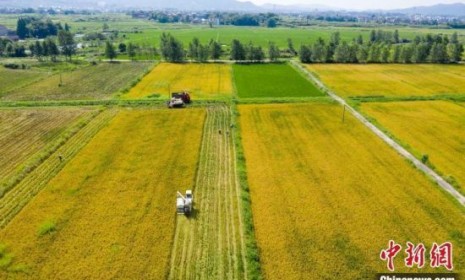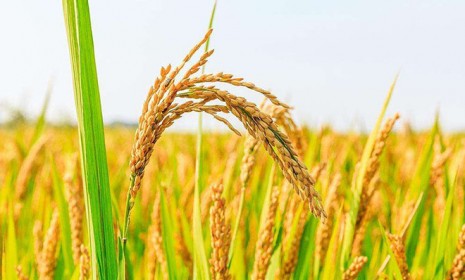近日,華中農(nóng)業(yè)大學(xué)果蔬園藝作物種質(zhì)創(chuàng)新與利用全國(guó)重點(diǎn)實(shí)驗(yàn)室、湖北洪山實(shí)驗(yàn)室、園藝林學(xué)學(xué)院李春龍教授課題組在Journal of Integrative Plant Biology上發(fā)表了題為“The CBL1/CIPK23 phosphorylates tonoplast sugar transporter TST2 to enhance the sugar accumulation in sweet orange (Citrus sinensis)”的研究論文,揭示了CBL1/CIPK23-TST2模塊響應(yīng)鈣信號(hào)通過調(diào)控液泡膜糖轉(zhuǎn)運(yùn)蛋白活性作用于柑橘果實(shí)糖積累的機(jī)制。
柑橘是我國(guó)及全球產(chǎn)量最高的水果,其風(fēng)味和營(yíng)養(yǎng)價(jià)值備受消費(fèi)者青睞。其中果實(shí)甜度是影響消費(fèi)者喜好和選擇的重要因素。可溶性糖主要積累于果實(shí)液泡中,這一過程依賴于液泡膜定位的糖轉(zhuǎn)運(yùn)蛋白,但目前關(guān)于柑橘果實(shí)糖分累積的具體機(jī)制尚未完全了解。
為了深入理解柑橘果實(shí)風(fēng)味品質(zhì)的形成以及調(diào)控機(jī)理,該研究在課題組前期柑橘果實(shí)液泡蛋白組的基礎(chǔ)上,發(fā)掘到與可溶性糖積累顯著正相關(guān)的液泡膜轉(zhuǎn)運(yùn)蛋白CsTST2。利用酵母和爪蟾蛙卵體系證明CsTST2具有轉(zhuǎn)運(yùn)己糖和雙糖的功能。通過柑橘汁胞瞬時(shí)轉(zhuǎn)化、柑橘愈傷組織及番茄材料穩(wěn)定遺傳轉(zhuǎn)化,證明過表達(dá)CsTST2可以顯著提高轉(zhuǎn)基因材料中糖含量,而干涉表達(dá)則降低糖含量。
通過酵母雙雜交文庫(kù)篩選,鑒定到與CsTST2互作的蛋白CsCIPK23。體外和體內(nèi)實(shí)驗(yàn)證實(shí)CsCIPK23與CsTST2非跨膜LOOP環(huán)互作,并且磷酸化Ser277/337/354位點(diǎn),以上位點(diǎn)突變?yōu)榉橇姿峄癄顟B(tài)后降低CsTST2的糖轉(zhuǎn)運(yùn)活性。進(jìn)一步分析表明CsCIPK23與CsCBL1互作響應(yīng)鈣信號(hào),并且CsCIPK23及鈣處理增加可溶性糖積累,這一過程依賴于CsTST2的存在及其磷酸化修飾水平。
綜上,本研究證實(shí)了CsTST2貢獻(xiàn)于柑橘果實(shí)液泡中可溶性糖的轉(zhuǎn)運(yùn)積累,而CsCIPK23通過與鈣信號(hào)傳感器CsCBL1形成復(fù)合物,磷酸化修飾CsTST2以增強(qiáng)其轉(zhuǎn)運(yùn)活性,進(jìn)一步促進(jìn)柑橘果實(shí)糖分的積累(圖2)。這項(xiàng)研究不僅揭示了CsTST2在柑橘果實(shí)糖積累中的重要作用,還為鈣信號(hào)調(diào)控果實(shí)風(fēng)味品質(zhì)形成的分子機(jī)制提供新的見解。
華中農(nóng)業(yè)大學(xué)園藝林學(xué)學(xué)院李春龍和劉繼紅教授為共同通訊作者,2022級(jí)果樹學(xué)博士研究生李夢(mèng)迪為該論文的第一作者。該研究依托華中農(nóng)業(yè)大學(xué)果蔬園藝作物種質(zhì)創(chuàng)新與利用全國(guó)重點(diǎn)實(shí)驗(yàn)室平臺(tái),獲得國(guó)家重點(diǎn)研發(fā)計(jì)劃項(xiàng)目、國(guó)家自然科學(xué)基金項(xiàng)目等項(xiàng)目資助。
【英文摘要】
Fruit taste quality is greatly influenced by the content of soluble sugars, which are predominantly stored in the vacuolar lumen. However, the accumulation and regulation mechanisms of sugars in most fruits remain unclear. Recently, we established the citrus fruit vacuole proteome and discovered the major transporters localized in the vacuole membrane. Here, we demonstrated that the expression of tonoplast sugar transporter 2 (CsTST2) is closely associated with sugar accumulation during sweet orange (Citrus sinensis) ripening. It was further demonstrated that CsTST2 had the function of transporting hexose and sucrose into the vacuole. Overexpression of CsTST2 resulted in an elevation of sugar content in citrus juice sac, calli, and tomato fruit, whereas the downregulation of its expression led to the reduction in sugar levels. CsTST2 was identified as interacting with CsCIPK23, which binds to the upstream calcium signal sensor protein CsCBL1. The phosphorylation of the three serine residues (Ser277, Ser337, and Ser354) in the loop region of CsTST2 by CsCIPK23 is crucial for maintaining the sugar transport activity of CsTST2. Additionally, the expression of CsCIPK23 is positively correlated with sugar content. Genetic evidence further confirmed that calcium and CsCIPK23‐mediated increase in sugar accumulation depends on CsTST2 and its phosphorylation level. These findings not only unveil the functional mechanism of CsTST2 in sugar accumulation, but also explore a vital calcium signal regulation module of CsCBL1/CIPK23 for citrus sweetness quality.
日期:2025-02-03
柑橘是我國(guó)及全球產(chǎn)量最高的水果,其風(fēng)味和營(yíng)養(yǎng)價(jià)值備受消費(fèi)者青睞。其中果實(shí)甜度是影響消費(fèi)者喜好和選擇的重要因素。可溶性糖主要積累于果實(shí)液泡中,這一過程依賴于液泡膜定位的糖轉(zhuǎn)運(yùn)蛋白,但目前關(guān)于柑橘果實(shí)糖分累積的具體機(jī)制尚未完全了解。
為了深入理解柑橘果實(shí)風(fēng)味品質(zhì)的形成以及調(diào)控機(jī)理,該研究在課題組前期柑橘果實(shí)液泡蛋白組的基礎(chǔ)上,發(fā)掘到與可溶性糖積累顯著正相關(guān)的液泡膜轉(zhuǎn)運(yùn)蛋白CsTST2。利用酵母和爪蟾蛙卵體系證明CsTST2具有轉(zhuǎn)運(yùn)己糖和雙糖的功能。通過柑橘汁胞瞬時(shí)轉(zhuǎn)化、柑橘愈傷組織及番茄材料穩(wěn)定遺傳轉(zhuǎn)化,證明過表達(dá)CsTST2可以顯著提高轉(zhuǎn)基因材料中糖含量,而干涉表達(dá)則降低糖含量。
通過酵母雙雜交文庫(kù)篩選,鑒定到與CsTST2互作的蛋白CsCIPK23。體外和體內(nèi)實(shí)驗(yàn)證實(shí)CsCIPK23與CsTST2非跨膜LOOP環(huán)互作,并且磷酸化Ser277/337/354位點(diǎn),以上位點(diǎn)突變?yōu)榉橇姿峄癄顟B(tài)后降低CsTST2的糖轉(zhuǎn)運(yùn)活性。進(jìn)一步分析表明CsCIPK23與CsCBL1互作響應(yīng)鈣信號(hào),并且CsCIPK23及鈣處理增加可溶性糖積累,這一過程依賴于CsTST2的存在及其磷酸化修飾水平。
綜上,本研究證實(shí)了CsTST2貢獻(xiàn)于柑橘果實(shí)液泡中可溶性糖的轉(zhuǎn)運(yùn)積累,而CsCIPK23通過與鈣信號(hào)傳感器CsCBL1形成復(fù)合物,磷酸化修飾CsTST2以增強(qiáng)其轉(zhuǎn)運(yùn)活性,進(jìn)一步促進(jìn)柑橘果實(shí)糖分的積累(圖2)。這項(xiàng)研究不僅揭示了CsTST2在柑橘果實(shí)糖積累中的重要作用,還為鈣信號(hào)調(diào)控果實(shí)風(fēng)味品質(zhì)形成的分子機(jī)制提供新的見解。
華中農(nóng)業(yè)大學(xué)園藝林學(xué)學(xué)院李春龍和劉繼紅教授為共同通訊作者,2022級(jí)果樹學(xué)博士研究生李夢(mèng)迪為該論文的第一作者。該研究依托華中農(nóng)業(yè)大學(xué)果蔬園藝作物種質(zhì)創(chuàng)新與利用全國(guó)重點(diǎn)實(shí)驗(yàn)室平臺(tái),獲得國(guó)家重點(diǎn)研發(fā)計(jì)劃項(xiàng)目、國(guó)家自然科學(xué)基金項(xiàng)目等項(xiàng)目資助。
【英文摘要】
Fruit taste quality is greatly influenced by the content of soluble sugars, which are predominantly stored in the vacuolar lumen. However, the accumulation and regulation mechanisms of sugars in most fruits remain unclear. Recently, we established the citrus fruit vacuole proteome and discovered the major transporters localized in the vacuole membrane. Here, we demonstrated that the expression of tonoplast sugar transporter 2 (CsTST2) is closely associated with sugar accumulation during sweet orange (Citrus sinensis) ripening. It was further demonstrated that CsTST2 had the function of transporting hexose and sucrose into the vacuole. Overexpression of CsTST2 resulted in an elevation of sugar content in citrus juice sac, calli, and tomato fruit, whereas the downregulation of its expression led to the reduction in sugar levels. CsTST2 was identified as interacting with CsCIPK23, which binds to the upstream calcium signal sensor protein CsCBL1. The phosphorylation of the three serine residues (Ser277, Ser337, and Ser354) in the loop region of CsTST2 by CsCIPK23 is crucial for maintaining the sugar transport activity of CsTST2. Additionally, the expression of CsCIPK23 is positively correlated with sugar content. Genetic evidence further confirmed that calcium and CsCIPK23‐mediated increase in sugar accumulation depends on CsTST2 and its phosphorylation level. These findings not only unveil the functional mechanism of CsTST2 in sugar accumulation, but also explore a vital calcium signal regulation module of CsCBL1/CIPK23 for citrus sweetness quality.
日期:2025-02-03















